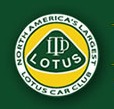I discovered Lotus cars while I was in college. I heard that British Motorcar Distributors in Anaheim had a DeTomaso Mangusta in the showroom and I went to look at it. That stunningly beautiful car, an
early Giugiaro design, was there to admire, the doors locked of course. While I was ogling the Mangusta I happened to notice the Lotus Europa's sitting nearby. The BMC distributor was also selling Lotus Elan's
and Europa's. My interest in the Europa was piqued because it was also a mid-engine design, the newest performance layout, and it was like a smaller version of the Magusta. It was also much lower in price.
This was my introduction to Lotus and several years later after I finished school I was able to buy a used Europa from Bob Challman's dealership in Manhatten Beach. It was British Racing Green with yellow
racing stripes, just like the Lotus racing cars of the 60's. Bob was noted for, among other things, putting stripes on everything. The car had 12500 miles on it when I bought it and later I discovered that it was the
same car I'd seen at Riverside Raceway the year before and taken some photos of.
I spent my formative years in this car. I put 100,000 miles on it as it was my daily driver. For this I should probably get some kind of award! It was a revelation to drive, and it forever influenced my driving "style"
and taste for small light and relatively low powered cars. It was an education in the benefit of low mass and efficient design which influenced my design style to this day.
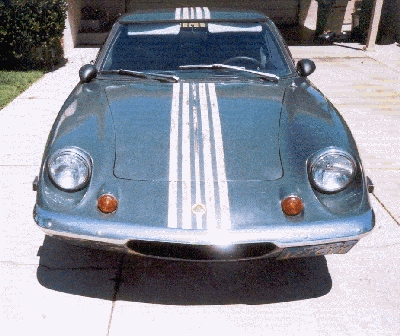 |
Originally the stripes as installed by Bob Challman were tape. I replaced these with paint after years of sun had degraded the tape. Eventually the painted stripes needed restoration too.
My car was the type 65 series which was prepared for the US market. One modification from the original type 46 was raising the headlamps by reshaping and raising the fender line. This had the effect of slightly destroying the
appearance of the front of the car - the early cars looked right and these looked a bit awkward. The opening on the fender for the headlights on the orignal was oval shaped, as compared with the lines on mine. The
ride height was also raised too, which of course I had to correct!
|
|
The rear of the car was rather high to clear the relatively tall Renault engine. These cars were originally marketed in Europe (it's a Europa, right?) thru the Renault connection.
The sail sections were the cause of the car being referred to as a "breadvan". On the later Twin Cam model the sail area was cut down to improve rear visibility, to the further degradation of the appearance in my
opinion.
The body was actually designed around front and rear (English) Ford bumpers, as was typical of early Lotus cars which used many parts from other production cars.
|
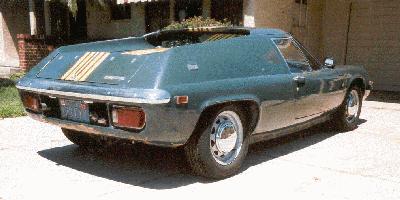
|
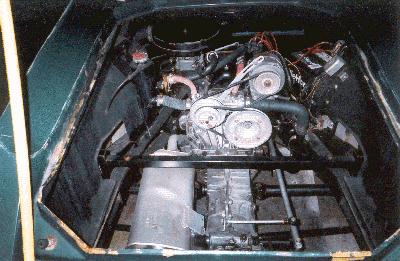 |
The mid-mounted engine and transaxle were sourced from the Renault R16, turned back to front from the original vehicle. It was a simple all aluminum 1565cc 4 cylinder OHV engine with a about 85 hp. For the US
type 65 model, Renault modified the engine for Lotus with increased power and emissions equipment. It was the beginning of the emissions regulations era.
Despite the relatively low power, the car only weighed 1500 lbs, so it was very quick and nimble - all the things that were famously Lotus.
The rear luggage compartment which used the space above the transaxle was removed for this photo. Once removed, accessibility to the drivetrain was excellent.
The radiator was mounted in the right front fender well. Long pipes ran thru the backbone chassis to the front.
|
|
The front compartment housed the spare tire, brake master cylinder, ventilation fan, radiator and a small luggage area.
The radiator can just be seen in the lower corner. Hot air exited into the right fender well. An electric fan was installed on the front of the core.
|
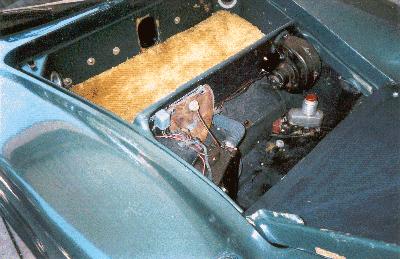
|
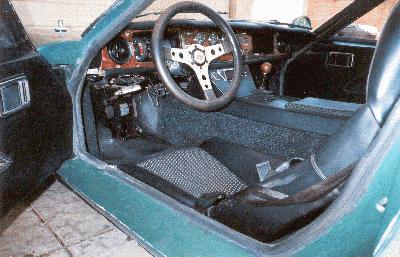 |
The interior was very compact and featured reclining seats. This was one of the cool parts of the car and forever influenced my preferred seating position - can you say Jimmy Clark?. The rim of the steering wheel was
only a couple of inches from the steeply raked windshield - you could touch it if you pointed your fingers.
The larger center console results from striding the backbone chassis. The world's shortest gearshift lever juts up from the backbone. The throws were very short and positive despite the long mechanism
that ran to the back of the transaxle.
The steering wheel is not original and it's from a Bricklin as I recall. The orginal was similar but I replaced it when the rim split apart.
The pedals were miniscule, fortunately so are my feet!
|
|
The polished wood dashboard was typical of British sports cars of that era.
Legroom was pretty good - if you weren't too big.
|
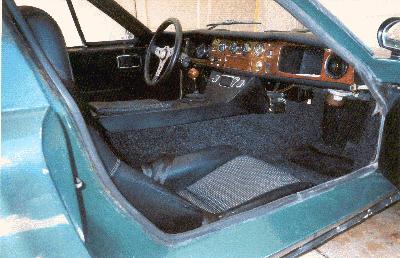
|
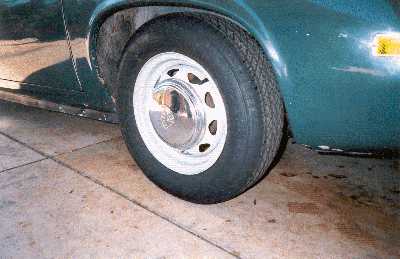 |
The wheels were only 13", tires only 155 wide, but with the light weight the grip was great.
Handling balance was terrific too.
|
|
Here's the car doing what it did best!
Now we call it "auto-x", we used to call it "slalom".
|
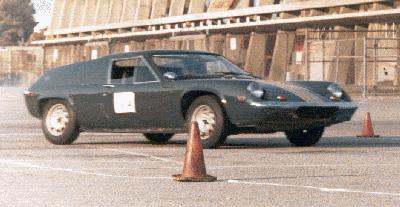
|
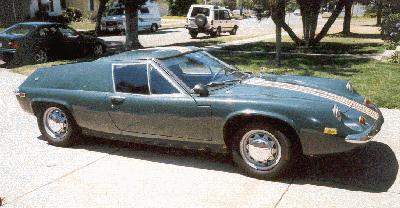 |
The BRG breadvan, knee high to a grasshopper, and went like stink.
|
|
This is Bob Challman's dealership in Manhatten Beach from the photo on the front of his business card.
This is how the dealership looked when I bought my car.
|
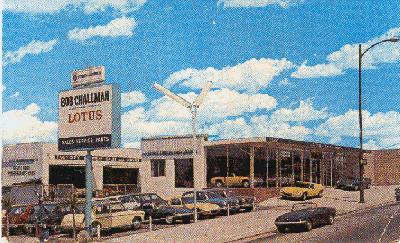
|
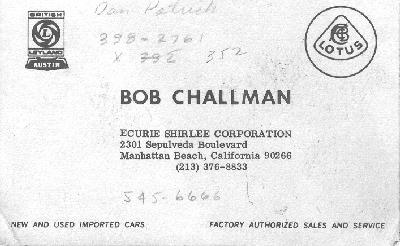 |
RIP Bob Challman, one of the unique characters in the Lotus story and responsible for the early success of Lotus cars in the US.
RIP Dan Patrick. Handwritten on the card is his name, the previous owner of my Europa. He traded it in on a new Twin Can Europa and later crashed and died in it while driving in the mountains near Yosemite.
When I was visiting that area a person looking at my car told me about some guy who'd crashed one into a tree there recently. Later when I was talking to Bob I found out that it had been Dan.
|






